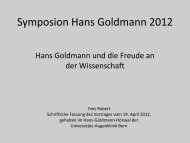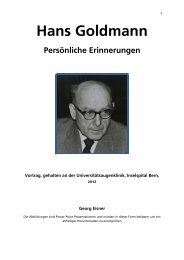Booklet - Georg Eisner, Ophthalmologie
Booklet - Georg Eisner, Ophthalmologie
Booklet - Georg Eisner, Ophthalmologie
Create successful ePaper yourself
Turn your PDF publications into a flip-book with our unique Google optimized e-Paper software.
Illustrations in high resolution<br />
In addition to DVD-videos, the discs contain scientific illustrations in high<br />
resolution for printing or embedding in PowerPoint presentations.<br />
The additional material is accessible only when using the DVD as a normal<br />
data disc on a personal computer (PC or Macintosh).<br />
Artwork<br />
The use of artistic drawings as well as video-sequences combines the advantages<br />
of both imaging techniques: the continually moving scenery during slit<br />
lamp examination which the examiners must stabilize in their minds, and the<br />
comprehensive view of the artist.<br />
In addition, for posterity’s sake, we have saved a form of art doomed for<br />
oblivion: pictures drawn after nature by artists especially trained in biomicroscopic<br />
examination techniques. One series was drawn by Adelheid Meyer for<br />
the Goldmann collection that was part of the Swiss contribution to science<br />
at the World Exhibition in Bruxelles in 1958 (partially published in the “Rapport<br />
de la société française d’ophtalmologie 1958”, now at the University Eye<br />
Hospital, Inselspital, Bern). The other set was drawn by Willi Hess for various<br />
publications authored by <strong>Georg</strong> <strong>Eisner</strong> (now at the Institute for the History<br />
of Medicine, Bern). The graphical work was drawn by Hans Holzherr (with<br />
some parts especially designed for this program, while others made for<br />
the DVD program: <strong>Georg</strong> <strong>Eisner</strong>, Introduction to Biomicroscopy of the Eye,<br />
Haag-Streit AG, 2002).<br />
Copyright<br />
© Schweizerische Ophthalmologische Gesellschaft /<br />
Société suisse d’ophtalmologie / Società svizzera di oftalmologia<br />
Copying is permitted under the condition that no changes are made in any<br />
parts of the program and its presentation.<br />
Using parts of this program is permitted with acknowledgment of<br />
the source: “<strong>Eisner</strong> <strong>Georg</strong>: Dr. Sherlock’s Vitreous; DVD Supplement<br />
to the Goldmann-Lecture 2008 (© Schweizerische Ophthalmologische<br />
Gesellschaft, 9435 Heerbrugg, Hrsg.)”<br />
About this program<br />
“By <strong>Georg</strong>e!” cried the inspector. “How ever did you see that”<br />
“Because I looked for it.”<br />
(From Sherlock Holmes “The Adventure of the Dancing Men”)<br />
Sherlock Holmes (whose creator, Sir Arthur Conan Doyle, happened to be<br />
a trained ophthalmologist) has always been one of my favourite heroes. His<br />
example guided me whenever I taught students the art of observing minute<br />
signs that can be easily overlooked, the kind of signs that Sherlock would have<br />
pointed out to his rivals at Scotland Yard with a fine twinkle in his eye.<br />
I myself was taught this art by Hans Goldmann, my venerable teacher, who<br />
would insist on our looking out for discreet, concealed, and unexpected signs<br />
indicative of a correct diagnosis. The vitreous is indeed a treasure trove for<br />
such signs.<br />
In this program, Dr. Sherlock is a lady, in honor of my mother, Dr. Irma <strong>Eisner</strong>-<br />
Guggenheim, who was among the first women ophthalmologists in Switzerland.<br />
I also like to pay tribute to my teachers Hans Goldmann, Peter Niesel,<br />
and Franz Fankhauser, who taught me not only the art of ophthalmology as<br />
such, but also the pleasure of further promoting it. Passing on this heritage to<br />
future generations has been our main goal.<br />
“Introduction to Biomicroscopy in the Clinical Examination of the Vitreous”<br />
contributes to this goal in two ways. On the one hand, it contains a textbook<br />
offering a systematic approach to the anatomy and the pathology of the vitreous.<br />
On the other hand, it also includes a compilation of video-sessions of<br />
selected cases with Dr. Sherlock explaining vitreous signs indicative of posterior<br />
segment pathology. Links are provided to switch from one section to the<br />
other and thus to correlate actual cases with their theoretical background.<br />
<strong>Georg</strong> <strong>Eisner</strong><br />
Terminology<br />
Terminology in the field of the vitreous is often misleading because historical<br />
factors and local preferences have led to the use of identical terms for different<br />
anatomical structures. To avoid confusion, only descriptive terms are used<br />
in this program. The aim is not to replace established local usage, but merely<br />
to simplify the access to this program for users with different backgrounds.








